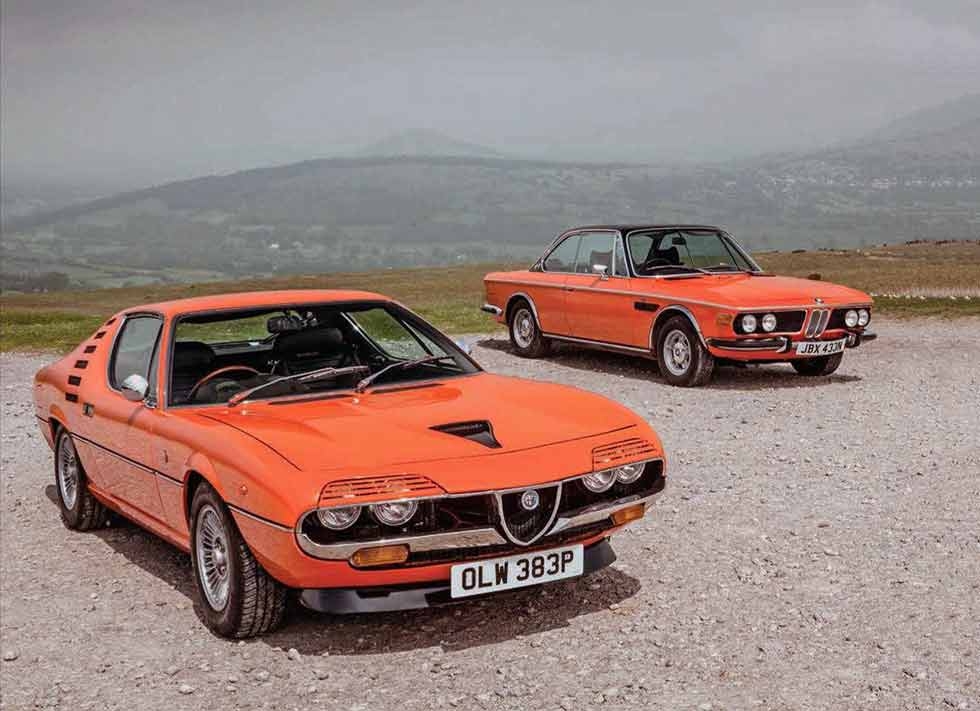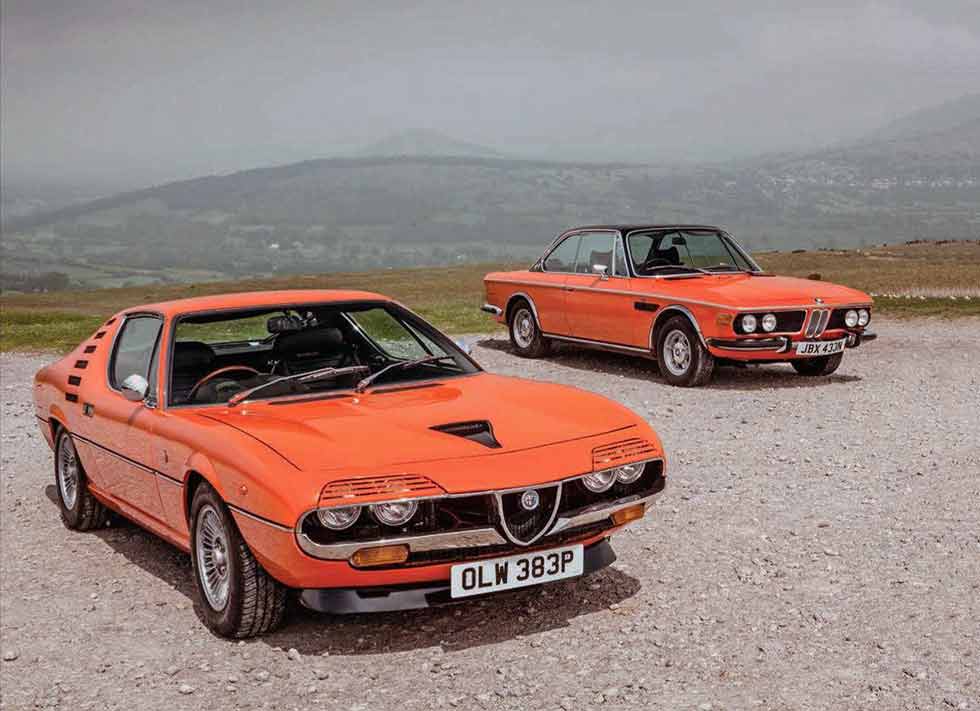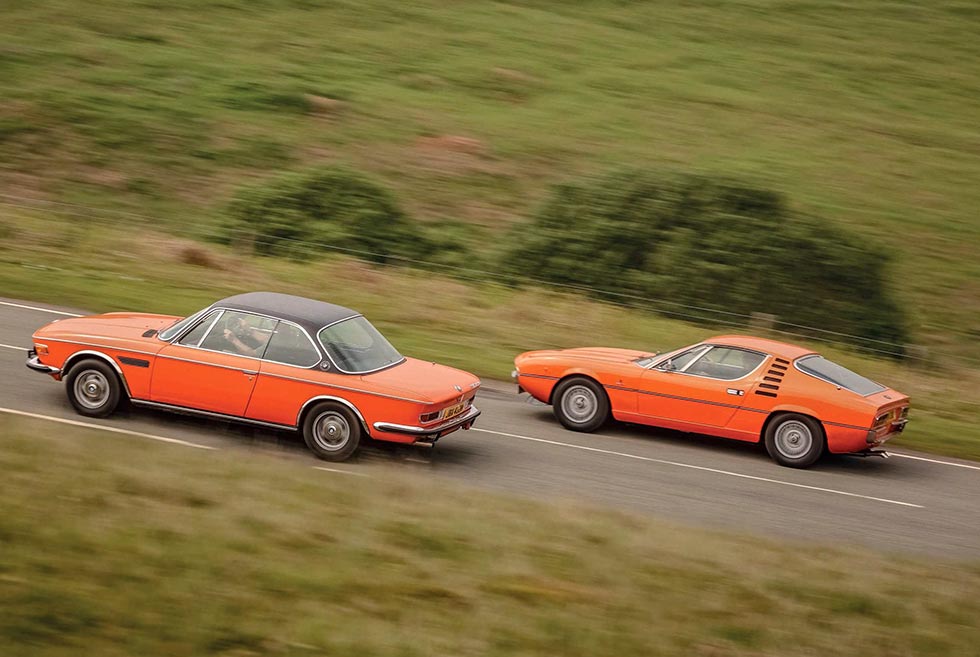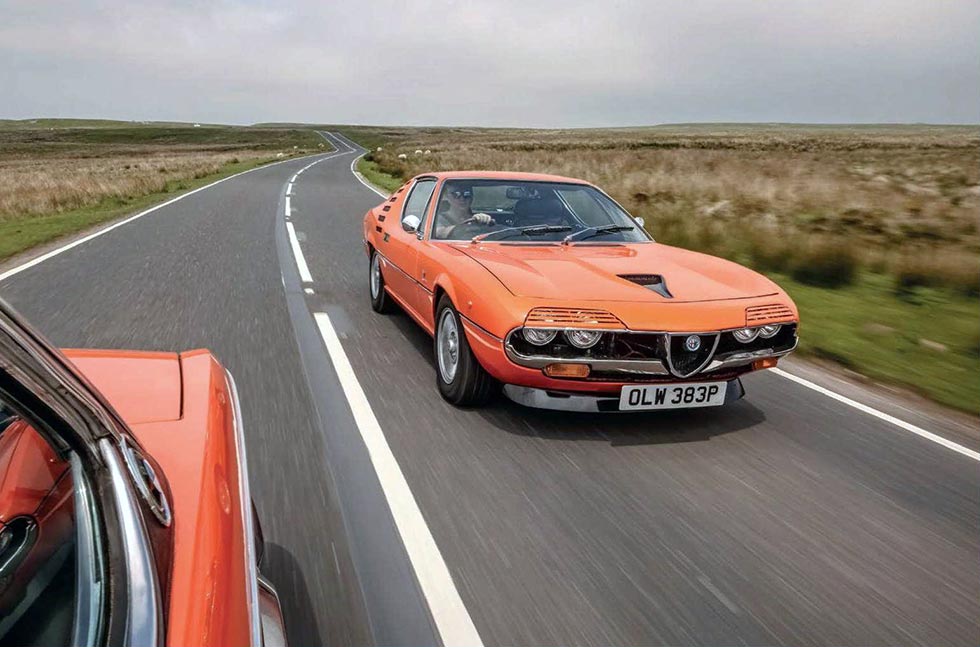
Practical Exotica. Can’t afford a CSL? The CSi is almost as good… but can it beat an Alfa Montreal? The CSi offers the CSL E9 experience for a lot less cash, and has more than just colour in common with the exotic Alfa Montreal. Words Martin Buckley. Photography Tony Baker.
TANGERINE DREAM MACHINES BMW’S GREATEST Glorious 3.0 CSL in detail, plus CSi vs Alfa Montreal
Two junior exotics in the Brecon Beacons on a sunny day in June hardly counts as ‘work’ really, does it? It was one of those days where that internal voice reminded me that this is a hobby I get paid for, not what most would call a ‘proper job’. Great scenery, great cars, great roads to drive them on and all with the full sanction of Gareth Lewis, who (handily) owns both and was enjoying himself as much as I was. The general mood was so positive that I didn’t even let the fractious encounter with an irate local or the fact that I lost my digital voice recorder (to an inquisitive sheep) spoil our afternoon.

No, it was an hour or two later, when that silver Peugeot 309 ‘reversed’ silently out of the pub car park into the road in front of the orange BMW that I started to think somebody might have it in for us on this shoot. Following in the (also orange) Alfa, I was suddenly plunged into a world of brake lights and screaming rubber as the BMW nose-dived and its Michelin XWXs locked up (in a nice straight line).
I followed suit, registering surprise and relief when, in plumes of burnt rubber, the Montreal’s snout came safely to a halt a mere six inches short of the BMW’s bumper; soggy pedal or not, there’s nothing wrong with those Alfa Romeo brakes. The only damage was a scuffed bumper on the Peugeot, having slipped its moorings due to a faulty handbrake.
Just before all this drama unfolded, I was beginning to think I rather liked the swaggering Montreal. Compared to the elegant, capable BMW it was as much a flawed oddity as ever, of course: poorly packaged, needlessly flashy but also easy to drive, flexible, fast enough and surprisingly refined.

I was even starting to forget about its heavy steering and forgive its woeful ventilation (and visibility), and just enjoy the sophisticated warble of its quad-cam V8, the chunky machismo of its ZF gearbox and the overwhelming sense that I was driving something really special and truly exotic with a sense of joy about it.
The Montreal was built from 1971-’1977 to the tune of just 3925 cars. The shape, designed by Gandini out of Bertone, has its origins in a pair of prototypes built in just nine months for Expo 67 in Montreal. This was not just another automobile salon but the World’s Fair, hence Alfa’s understandable flattery at being the only manufacturer asked to contribute a dream car under the heading ‘Ultimate aspirations in the automobile field’. It emerged as a production vehicle, surprisingly visually unchanged, at Geneva in 1970. It was still swoopy and aggressive (with six giant vent grilles on both its rear quarters suggesting a mid-engined configuration) and over its (fixed) quad headlamps sporting those slatted ‘eyelids’, which were vacuum-operated and flipped down rather than up.
The four-cylinder donkey engine of the pearl-white show cars had been replaced by a short stroke, 2.6-litre quad-cam V8, front-mounted and suitably civilianised (cross- rather than flatplane crank and so on), but still recognisably the Tipo 33 sports-racing car unit, class-winning star of the Targa Florio, Daytona and Le Mans. Mechanically fuel injected by Spica, with Bosch providing the big sparks from a fancy new capacitor-discharge transistorised ignition system, this all-alloy, dry-sump, wet-linered 200bhp V8 was a formidable piece of technology – just what you would expect to find under the bonnet of a car that looked like a baby Miura. Not so the chassis architecture, which, with the exception of big ventilated discs all round, was the same well-honed and successful recipe found under Alfa’s 105-series family of saloons and man-about-town GTV coupés.
Attempts by Alfa’s brochure copywriters to make a virtue out of the fact that this near-140mph, £5000 luxury grand-touring car was running a live axle (albeit light, well-located and with an LSD) because it meant that the road-holding was more ‘predictable’, sounded about as convincing as its claims that they had put the body into production simply because the prototype had been so overwhelmingly well received by visitors to Expo 67.

As ever, the truth lies somewhere in between, probably in the fact that Alfa Romeo needed a replacement for the late, and not very lamented, 2600 Sprint as a flagship model. The company was also, perhaps, looking enviously at the promotional value of the Dinos for Fiat. The Dino Coupé was certainly a natural rival for the Alfa Romeo Montreal – indeed, the two would be built on the same production lines at the Bertone factory for a while.
Montreal production began in May 1971 and almost 700 were sold that year; 1972 was by far its best year with 2350 sold, but it took Alfa until 1977 to dispose of the remaining 900 examples. Meanwhile, on the other side of the Alps, BMW was having a much happier time with its six-cylinder E9 coupés.
In 1968 2800 CS form it had already received rave reviews in America.With more power and better brakes as the 1971 3.0 CS, it was well on the way to being the most successful car in the luxury-coupé class, despite notoriously high prices and a nagging concern that its Karmannbuilt, pillarless body was neither as modern nor as rigid as the E3 six-cylinder saloons with which it shared its drivetrain. Aft of the front windscreen pillars, the E9 shell started life as the 1965-’1969 2000 C/CS, but it had been subjected to such a successful front-end restyle in 1968 that buyers didn’t know (or perhaps they didn’t care) about its origins.
The basic shape can trace its roots back to the Bertone-designed-and-built 3200 CS, with its almost identical goldfish-bowl glasshouse. Thus, the link with Bertone was well established: I even have a theory that Gandini, working for Bertone, gave the six-cylinder E9 body that handsome, pointed nose. It is certainly, in my view, too pretty to be German.
With carburettors, the manual 3.0 CS would pull over 130mph. With Bosch D-Jetronic injection, the 3.0 CSi coupés, with the mandatory four-speed manual gearbox, would nudge 140mph. Thus on 200bhp (or, if you like, more than 1bhp per cubic inch), the big BMW coupés were in the 7.2-litre Jensen class, but with the potential, when driven moderately, to return 20mpg rather than 12.
Collectors tend to focus on the CSL these days, but these homologation specials, with their delicate aluminium panels and snug bucket seats, were a tough sell at the time and, in right-hand-drive form, hardly any lighter, or faster, than the CSi. What’s more, the CSi, with just 215 right-hookers sold in the UK, was always a much rarer car on these shores than the right-hand-drive lightweights, which numbered 500.
In a way, I was surprised to hear that Alfa Romeo shifted as many as 180 right-hooker Montreals, and that the firm even went to the trouble of creating a different exhaust manifold to accommodate the RHD steering box. Under the bonnet you can just see the four cam boxes almost hidden under the air-cleaner lid; remove it and you would find the long crossover inlet tracts and the Spica injection pump nuzzling in the middle of the 90º vee.
The Alfa is a cosy car inside with massive, looming instrument pods that (in contrast to the BMW’s obsession with warning lights) contain gauges for everything. The driving position is reclined, straight-armed but not excessively short-legged. Power windows were optional (but I have never seen a Montreal without them) and all this one lacks is air-conditioning. The heavy steering at low speeds and the absence of a decent boot or meaningful rear seats make this an immediately less handy car than the BMW.
Yet it has a smooth, refined drivetrain with lots of torque spread right across the rev range and the even, quiet tickover of a limousine that is at odds with the silky aggression it vocalises when asked to accelerate hard – something approaching a cliché of what an exotic Italian four-cam engine should be like. It sounds faster than it is, but in real terms, on the road, the Montreal is a match for the BMW in a straight line, particularly at higher revs where the spacing of its five gears, with a direct top rather than overdrive, are necessarily less of a compromise than the BMW’s four.
Not that there’s much wrong with the smooth, accurate Getrag gearbox in the 3.0 CSi. The low first squats the Bavarian coupé on its semi-trailing arms and squirts it up the road with all the sweet lustiness you remember, the noises up front the silky essence of what you expect from a 1970s BMW. That handsome, single-overhead camshaft straight-six, canted over at 30º, has a slightly hunting idle but makes a gloriously wholesome whine when extended. Revved to 6500rpm it would show over the ton in third, but it is equally happy to potter along the high street in that gear.
The fabulous all-round vision and the brilliant driving position make you well disposed to this car even before you’ve turned the key. It doesn’t have the groovy instrumentation of the Montreal – if anything, the CSi’s dials are on the small side – but somehow the elegant, dull-finish wood and the overall sturdy feel give you a sense of confidence and solidity.
In a way, however, this was partly an illusion, because these Karmann-built coupés, with their internal rust traps and poor undersealing, proved to be the fastest-corroding vehicles this side of an Alfasud. On this point at least, the Montreal is almost certainly the more durable of the pair, even if it doesn’t look it.
Neither of our contenders pretended to be absolutely the fastest way around a corner in the early ’70s, but the Alfa was at a disadvantage, partly because it looked like a ‘supercar’, but mostly due to higher expectations. This, after all, was the flagship offering from a marque that prided itself on making perhaps the best-handling production cars in the world.
Approached with the right frame of mind the Montreal is a stable, predictable and forgiving car to drive, that to some extent transcends the limitations of its live rear axle and nose-heavy weight distribution.
With good power steering, Alfa could have given it higher gearing, but once under way it’s a reasonable compromise between feel, feedback and effort. Understeering gently, it settles happily into really long, fast curves but is much less at home in slower, tighter ones, where the price of a surprisingly good ride on soft springs is more body roll than feels comfortable. The Montreal is fun to drive, but lacks the effortlessly symbiotic flow that makes a 1750 or 2000GTV such a joy on a twisty road. Latter-day owners have proved that this is easily cured with thicker anti-roll bars, but it seems odd that Alfa did not address it in period. It’s an omission that tends to suggest its creators lost interest in it almost immediately, or never really knew what the Montreal was supposed to be in the first place, its purpose lost in translation in the four-year hiatus between conception and production.
BMW, in contrast, knew precisely what it was doing with the 3.0 CSi. This was a car that succeeded – and, indeed, still succeeds – because it managed the tricky task of bringing the driver appeal associated with smaller models (such as the 2002) into the most expensive car in the Munich manufacturer’s line-up.
Drive it hard through sharp corners or long curves, take it for a lengthy, quiet cruise down a motorway, or just see how easy it is to park at the shops. The surroundings are posher, the ride is smoother and quieter, but the agile flavour is there, sure enough, with power steering that’s as sensitive a compromise between effort and accuracy as could be hoped for in the early ’70s, ensuring that the car’s inherently sure-footed poise on supple but roll-resistant springing can be fully exploited.
It shouldn’t matter all that much, 45 years or more down the road, that the BMW has fairly usable rear seats and a decent boot but, in truth, it sort of does. They are intrinsic to the elegant concept of a car that, for me, is still the most beautiful and desirable BMW of all.
As for the Montreal? I loved it. Yes, there are better Alfas out there, finer specimens of early ’70s junior exotica. But as an example of irrational Italian automotive design it is a gem that is sufficiently different in character from the BMW CSi E9 that I, like the lucky owner Lewis, could very happily own both.
OWNING BOTH: GARETH LEWIS
“The BMW was ordered new from Green Bower BMW and remained local to the dealership until my purchase,” says Lewis. “The original owner was a serial BMW buyer, who bought the latest model every two years: unlike most, he didn’t sell his old cars but kept them, amassing a collection of 13 low-mileage BMWs by the time he died. It’s done 52,000 miles and has only ever been serviced by the supplying dealer. It is largely original – hence it’s a bit rusty in places – but has slightly lowered, uprated springs and shock absorbers that sharpen the handling and reduce body roll. I’ll have to have it stripped and repaired at some stage – it’s a real keeper, so I’ll find the money from somewhere.
“I know less about the Alfa. It’s an original UK RHD car, with its last owner for 15 years. It is known to the Alfa Romeo Owners’ Club and has previous concours wins, but by the time I acquired it, the car had been badly repainted metallic orange, which had split and cracked. I’ve had it stripped to a bare tub, repainted the correct flat orange and had the suspension and so on rebuilt. This shoot was the first time it’d been on the road since completion.
“Both are beautifully styled. The Alfa engine is really rather special, but it’s harder work, a special-occasion car. The BMW is more relaxed and practical, in many ways the perfect all-round classic. Given that they are rarer than a standard CSL and are pretty much identical to drive, I don’t understand the massive price difference.”
Tech and photos
TECHNICAL DATA FILE SPECIFICATIONS ALFA ROMEO MONTREAL
Sold/number built 1971-’1977/ 3925
Construction steel monocoque
Engine all-alloy, dohc-per-bank 2593cc 90º V8, Spica fuel injection
Max power 200bhp @ 6500rpm
Max torque 173lb ft @ 4750rpm
Transmission five-speed manual, RWD
Suspension: front double wishbones, anti-roll bar rear live axle, twin trailing arms, A-bracket; coil springs, telescopic dampers f/r
Steering recirculating ball
Brakes discs, with servo
Length 13ft 10in (4216mm)
Width 5ft 6in (1676mm)
Height 3ft 11 ½ in (1204mm)
Wheelbase 7ft 9in (2362mm)
Weight 2800Ib (1270kg)
0-60mph 7.5 secs
Top speed 136mph
Mpg 21
Price new £5077
Price now £25,000-80,000
{module Alfa Romeo Montreal}
TECHNICAL DATA FILE SPECIFICATIONS BMW 3.0 CSi E9
Sold/number built 1971-’1975/8199
Construction steel monocoque
Engine iron-block, alloy-head, sohc 2985cc straight-six, Bosch D-Jetronic fuel injection
Max power 200bhp @ 5500rpm
Max torque 200lb ft @ 4300rpm
Transmission four-speed manual, RWD
Suspension: front MacPherson struts rear semi-trailing arms, coil springs; anti-roll bar f/r
Steering power-assisted worm and roller
Brakes vented discs, with two servos on right-hand drive cars
Length 15ft 3 ½ in (4658mm)
Width 5ft 6in (1676mm)
Height 4ft 6in (1361mm)
Wheelbase 8ft 7in (2624mm)
Weight 3030Ib (1376kg)
0-60mph 7.5 secs
Top speed 139mph Mpg 16-20
Price new £7399
Price now £12-55,000
{module BMW E9}
The Bertone-penned Montreal has Miura-esque lines, largely true to those of the two prototypes exhibited at Expo 67 in, you guessed it, Montreal. Clockwise from top: a wealth of gauges in the cosy cabin; live rear axle doesn’t help handling; the front-mounted V8 has bona fide racing heritage. BMW sold more than double the number of E9 3.0 CSis as Alfa Romeo did Montreals – and the German giant did so in two fewer years. Clockwise from top: great all-round visibility and super driving position; big boot aids practicality; Bosch D-Jetronic injected ‘six’ leans over at 30º. Just 215 right-hand-drive examples of this Karmann-built two-door were sold in Britain; it gives a polished ride despite this example being slightly lowered.
{CONTENTPOLL [“id”: 138]}
‘The Montreal’s purpose was lost in translation – BMW, in contrast, knew precisely what it was doing with the 3.0 CSi’





